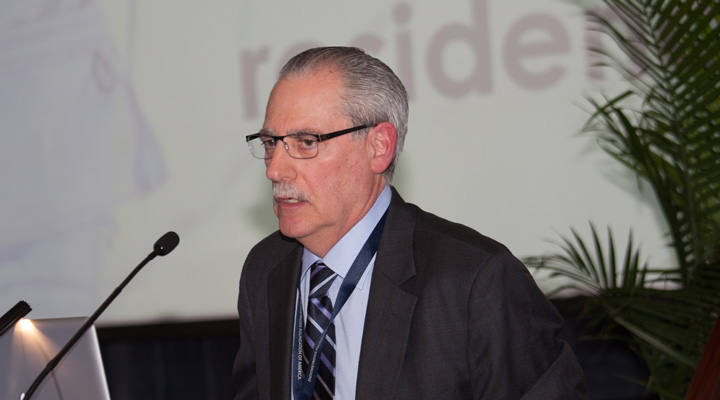Endofound’s Sixth Annual Medical Conference: Ending Endometriosis Starts at the Beginning
The sins of the fathers are visited on the sons: should hysterectomies be pre-certed other than vaginal?
Ray Wertheim, MD, FACOG
First of all I think I should have brought a football helmet. I am going to add a little bit to this controversy and I am feeling as if I am walking amongst giants and I cannot talk as fast as he did but I will do my best to stay on time.
It is truly a privilege and an honor for the invitation to address you today. I would like to thank the Endometriosis Foundation, Dr. Harry Reich and the AAGL for this opportunity. The title has changed and for good reason.
With all the changes in health care and patient physician relationships what should come first? Mandates on practice or patients? This subject has me greatly troubled. It possibly is going to affect all the women in this room, your mothers, your daughters, your sisters and your wives, all the women that you care about. There are potential limitations on the horizon by insurance companies on laparoscopic surgery that could affect a woman’s choice about the best surgery for her individual needs, particularly women who suffer with endometriosis. I believe patients come first. It is a guiding principle for me and I am sure many of you feel the same. That is why I believe so strongly in the benefit of laparoscopic hysterectomies for patients that need them.
I have no conflicts.
In 1988 Harry was the first. He had the vision of the advantages of minimally invasive surgery, whether it was laparoscopic or vaginal over open surgeries. “The reasonable man adapts himself to the world; the unreasonable one persists in trying to adapt the world to himself. Therefore all progress depends on the unreasonable man” (George Bernard Shaw). How does this apply to Harry? In 1988 when he first performed a laparoscopic hysterectomy most colleagues thought he was an unreasonable man. But he had a vision that this approach was safer, with a faster recovery than open surgery. However, acceptance and endorsement took many years. This is four years later. Look at these comments; an editor of a most prestigious journal his editorial: A Surgical Advance or Technical Gimmick” (Roy Pitkin). Fast forward 18 years before he relented and acknowledged the advantages of laparoscopy. During this time there were delays in publications and a media frenzy due to inappropriate comments by the medical community to the press. Terms such as barbaric and medical terrorism were used to describe operative laparoscopy. United Health Care, April 2015: All hysterectomies other than vaginal have to be pre-certified”. This is being justified by a 2009 ACOG bulletin.
In my opinion this is not about improving women’s health care. Let me tell you what this may mean. The surgeries may be denied or delayed. It may require appeals that are very time consuming and often without success. The medical directors are not accessible the company will not even tell us their names or how to get in contact. In short, the appeals process is very arduous and frustrating. So my question for you today is, should a third party administrator determine the mode of any type of surgery, brain surgery, heart surgery or gynecologic surgery? My answer is an emphatic no! It should be a decision between the physician and the patient.
The response from the medical community, ACOG, “Since every patient is different, many factors must be considered in order to determine the safest approach”. It went on to say “Decisions should be made between the physician and the patient”. Having said that I believe all options, surgical and non-surgical, should be discussed in an objective, non-biased and understandable way in order to help a patient make the best decision. The decision should be based on available data and expert opinion. In short, we try to practice evidence-based medicine.
The vaginal approach: with the vaginal approach you have very minimal visualization. Dr. Jon Einarsson, president elect of AAGL in Boston noted that there is no convincing evidence that vaginal hysterectomy requires a shorter hospital stay than a laparoscopic hysterectomy. Data from randomized trials show that patients have significantly higher immediate post-op pain levels after a vaginal hysterectomy. In addition, if I am doing a hysterectomy for endometriosis I really need to inspect the rest of the pelvis. If there is co-existing endometriosis if I do not resect it the patient is going to continue to be symptomatic. In addition to that ovarian cancer, we have now learned a lot of these cancers began in the fallopian tube, particularly the distal end. If you are operating vaginally you might even be able to get the tubes. In addition to that when you take the tubes out you really need to stay close to the tube otherwise you run the risk of compromising the blood supply to the ovary and create premature menopause, which subjects the woman to a whole other set of issues, and you just cannot get the right angles vaginally.
Some of you may remember Gilda Radner? She was on the original cast of Saturday Night Live. She wrote a book “There’s Always Something”. Her story is typical delayed diagnosis. She had the surgery, she had the chemo, she thought she was going to survive. At that point she wrote the book and subsequently died. We are just not good at ovarian cancer. It is probably the most deadly gynecologic cancer that we deal with. We have no good surveillance methods and we just do not pick it up early. Most gynecologists when they perform hysterectomies these days will take out the tubes. You can decrease the risks significantly.
Laparoscopically we have a wonderful view of the pelvis. But that is the uterus, tubes, ovaries. If you have a pelvis like this vaginal hysterectomy should always be a consideration but only in the appropriate patient with a surgeon with the necessary skills. And here is why, most of my surgeries are for pelvic pain and endometriosis. You can see this is the posterior uterus that is the bowel. Imaging studies do not show us this. You do not know what you have until the camera goes in. If you are operating vaginally you may not even see that and if you perforate the bowel you can get severe complications, you will need more surgeries and they can even die from this complication. The type of adhesions with endometriosis they are different. It is as if someone poured super glue into the patient. These adhesions are very dense and if you do not understand the anatomy and you cannot dissect and understand the planes you are going to have complications.
Today in America what is taught is not what is expected during residency and there are a number of good reasons for this. There are less hysterectomies are being performed, there are more different types of hysterectomies, the residents work less hours so the best and safest approach needs to be carefully chosen and adequate training is essential. Our surgical skills are directly related to education, practice, continued studying and the volume of surgeries that we perform. This was in AJOG this month. It was a study where they queried the program directors in the United States and Canada. Forty-one percent of the program directors were not satisfied with current laparoscopic training. But even more disturbing 94 percent of the programs do no testing for knowledge. Do the residents know the anatomy? Do they know the variance in the anatomy, do they understand what endometriosis does to change the anatomy? Ninety-one percent do no testing for skills. Do the residents know how to safely insert the trocars? Do they understand the instruments and limitations of the instruments? Testing has been done in Europe for years. The general surgeons in our country have been doing testing for years so we do not have to reinvent the wheel. I have not seen any studies regarding vaginal hysterectomies because that data probably does not exist and so few are being performed.
A resident today typically performs 15 to 20 vaginal hysterectomies during their entire four years of training. In some programs they do as few as three during their entire training, clearly not enough to gain the knowledge and skills needed.
What are the proposed solutions? Better teaching methods and we need more structure. We need to test the residents for knowledge and skills. Possibly separate obstetrics and gynecology since there is so much to learn. Lengthen the training programs. Graduate medical education in the United States today is focused on cost, so that has gained no traction.
We have established comprehensive centers of excellence. I am the director of one, so I will teach, I will mentor and I will proctor surgeons before they are allowed to solo after all the operating room is not the laboratory. It is all about safety. We have created fellowship programs where the residents can do one to two years to gain the knowledge and skills to perform these surgeries safely. And lastly, better communication with patients without conflicts of interest. And let me repeat that, without conflicts of interest.
This billboard would leave you to believe that robotic surgery is better. The younger generation loves technology. Regardless of the tools used it is really all about the anatomy and knowing how to dissect. We have wasted millions of dollars on technology and robotics without improving outcomes in benign gynecology. Once a hospital buys this expensive machine if you look on their hospital site on the internet they will use language leading you to believe that robotic surgery is better because they need to use the machine to pay for it. I am ashamed to say that a lot of physicians will use the robot to market themselves.
I just saw this a few days ago and I added it because it is relevant. One of the justifications for using robotics is ergonomics, less eye strain, less fatigue. This was a study in the European literature done in northern Norway. The numbers are small but it is interesting. These residents had already gone through a formal curriculum regarding ergonomics and then they took a post-test. If you look their knowledge after having taken the course on the post-test is abysmal. The conclusion is that current curriculum devotes insufficient time and resources to ergonomics. I am not even sure that we have any formal programs in the United States regarding ergonomics.
I am lucky. In my hospital I have my own room and my own team. So anesthesia knows they do not put the patient to sleep until I already have her positioned to prevent pressure points. They know I want the stomach emptied before I place my first trocar. Those are safety issues. But then they know the table height I want, they know where I want the monitor, they know how I want the room laid out and all that improves the ergonomics to help prevent fatigue.
We need to do a better job communicating and not hide behind medical lingo. We should use diagrams and allow plenty of time for questions for our patients. I typically spend about an hour with each patient during the pre-op visit. The physician/patient relationship must be protected. We have to put our patients first; women deserve choices not mandates by insurance companies. After all, our highest priority must be to keep all the women in our lives safe. Women deserve better care than mandates. Insurance companies should not limit the rights of women to make good, informed decisions.
I know Harry never believed that the laparoscopic hysterectomy should replace the vaginal hysterectomy. However, operative laparoscopy is a tremendous advancement in women’s health care. With the high definition magnified cameras and new instrumentation we can perform these surgeries through incisions approximately half an inch in diameter. Our patients typically go home two hours later and within two weeks they are back to taking care of their families or back to work. This is very different from the recovery from open surgery. It remains to be seen if we as physicians and a nation have the moral courage to make the necessary changes in order for women to get the health care they deserved at reasonable costs.










